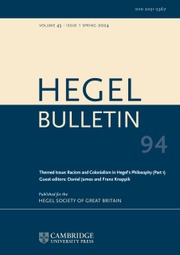No CrossRef data available.
Article contents
Kant's Cognitive Semantics, Newton's Rule Four of Philosophy and Scientific Realism
Published online by Cambridge University Press: 22 April 2013
Abstract
Kant's Critique of Pure Reason contains an original and powerful semantics of singular cognitive reference which has important implications for epistemology and for philosophy of science. Here I argue that Kant's semantics directly and strongly supports Newton's Rule 4 of (natural) Philosophy in ways which support Newton's realism about gravitational force. I begin with Newton's Rule 4 of Philosophy and its role in Newton's justification of realism about gravitational force (§II). Next I briefly summarize Kant's semantics of singular cognitive reference (§III). I then show that the key point of Kant's cognitive semantics is embedded in and strongly supports Newton's Rule 4, and that it rules out not only Cartesian physics (per Harper) but also Cartesian, infallibilist presumptions about empirical justification generally (§IV). Finally, I argue that Kant's semantics reveals a key defect in the original version of Bas van Fraassen's anti-realist ‘Constructive Empiricism’, and in many common objections to realism (§V). Fortunately, Kant's semantics of singular cognitive reference stands independently of his Transcendental Idealism; nothing I argue in this paper depends at all upon that doctrine.
In experimental philosophy, propositions gathered from phenomena by induction should be considered either exactly or very nearly true notwithstanding any contrary hypotheses, until yet other phenomena make such propositions either more exact or liable to exceptions. (Newton 1999: 796)
- Type
- Research Article
- Information
- Bulletin of the Hegel Society of Great Britain , Volume 32 , Special Issue 1-2: Special Issue on Kant and Hegel , 2011 , pp. 27 - 49
- Copyright
- Copyright © The Hegel Society of Great Britain 2011




